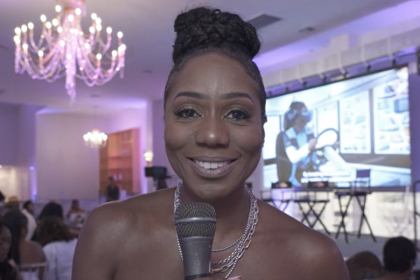
Dr. Yolanda Ragland practices podiatric medicine. A podiatric reconstruction forefoot surgeon, Dr. Ragland maintains a Park Avenue office in New York City and one in the DMV, downtown Silver Spring Maryland. She focuses on bunion and hammertoe correction with her trade secret, the Tiara-Toe technique.
“I understand that patients want to have sandal-ready feet with little to no visible scarring. After having a consultation with me, new patients realized I truly understand the angst they experience and they are confident that I will address their concerns with their feet,” she offers.
Read what else she has to say.
What is the biggest medical issue(s) you see with women as it relates to their choices in footwear?
The most common complaint in my practice by far is corns on the top of the toes. A corn is a thickening of the skin due to constant pressure or rubbing. Corns are commonly called hammertoes. Hammertoes are a result of excessive bending of the toes and when the toes are confined to shoes, the joints rub against the shoe. As a result, the skin tries to protect itself by forming a thick corn versus breaking down and ulcerating.
These corns can be extremely painful. Subsequently, the corns can also be awfully embarrassing, particularly to African American women. On darker complexions, the corn can present in extreme contrast to the unaffected skin, either appearing much lighter or darker. Furthermore, there are two joints on each lesser toe, which means there can be two corns present on each toe exacerbating the unsightly appearance as well as the pain.
This condition can really play into the overall psyche of a woman. A stylish lady is now limited to shoe selection. An otherwise confident woman feels self-conscience about wearing sandals, taking barefoot walks on the beach or even uncomfortable in her own home when she has company. My Tiara-Toe technique is a breakthrough resolution to corn removal resulting in corn-ridden toes with virtually no scarring.
What is a good height for a woman’s shoes for daily wear? Is there a way to make a determination?
Determining how high of a heel to wear daily is analogous to pinpointing when someone will completely heal from bunion or hammertoe surgery. What I tell my patients is “You’ll never get a straight answer from me.” That is because healing from any surgical procedure is variable from patient to patient. The same is true for tolerating high heels. The variables to which pump height someone should wear include, foot type (flat feet, high arch, bunion, hammertoes, narrow or wide width), the structure and workmanship of the shoe, materials of the shoe, how coordinated one may be and what is the individual’s threshold for pain.
Blistering from shoes is a red flag that perhaps this is not the heel for you because blistering can result in callusing of the skin and ultimately straining and spraining of muscles and ligaments and can compromise the bony structures they surround. But, who wants to banish that perfect pump? You may have spent part of your rent money so you could purchase them. It goes with your hottest getup and attracted the eye of that smoking hot, bearded guy you now have plans to go out on a date [with]. In reality, shoes can be rigid initially. When they are less supple, they are more likely to rub against your skin and cause blisters, corns and calluses. You may need to break in your shoes. You can do so by wearing them on the first day for one hour, second day for two hours, the third day for three and so on. Let’s face it. That’s just not practical.
A favorite shoe hack is moleskin. Moleskin prevents friction, which is directly related to the formation of blisters. It is preferable to place it directly in the shoe over the area that is affected versus sticking the moleskin directly to the skin. Also, owning a pair of wooden shoe stretchers is a must. Keeping them in overnight works supreme. Additionally, walk with a pair of safety shoes. Inexpensive compact flats that can fit into the smallest of clutches are readily available online.
If one must partake in extreme heels, limit wearing them to three to four times per month. Put off long walks and try not to wear them when walking on concrete. It’s not just bad for your feet, but it is also brutal on your shoes. Changing your shoes every two to four hours should provide adequate relief and will decrease your chances of damaging your feet.
Additionally, remember to stay mindful of the time of day when purchasing your next pair of heels. Try them on at the end of the day when your feet are most swollen. Although your shoes should fit snugly they should not feel tight. Likewise, they should never be loose. Loose-fitting [shoes] will cause just as much damage to your feet as shoes that are too small. Finally, if they are marginally uncomfortable in the store, they will definitely hurt when you go out with your girls or that cute guy.
Is it good to always wear flats?
It is a complete misnomer that flat shoes are better for your feet than heels. The fact is wearing completely flat shoes can be just as harmful to your feet as wearing extremely high heels all the time. Shoe that do not provide arch support and do not slightly elevate the heel can cause an already falling arch to collapse completely, which can result in a torn tendon which will require surgical repair. Flats can also cause a condition call plantar fasciitis. This condition is commonly called heel spur syndrome. However, the spur is rarely caused [by] the condition. It is caused by excessive flattening of the arch, which puts strain on the plantar fascia, which eventually is compromised, and tears, eliciting excruciating pain with the first few steps after resting. Other problems may arise with supportive flats [that] can give rise to the same issues the high heel may precipitate, such as losing your foot’s natural cushion and sock absorber known as fat pad atrophy, strains and sprains and stress fractures.
Are wedges and/or platform shoes better? Worse? Or about the same as stilettos?
Any high heel may cause malalignment in the back. Wedge heels may be more comfortable when accompanied with a platform. The broad base of a wedge feels more stable than balancing on a narrow stiletto. However, having a broader based does not eliminate the chances of twisting an ankle. Also, when a wedge is coupled with a platform the declination angle of the foot is reduced, which means there is less pressure on the ball of the foot which means less strain on the foot entirely.
For more information, visit FixYourFeet.com or call 1 (877) 403-1929.









